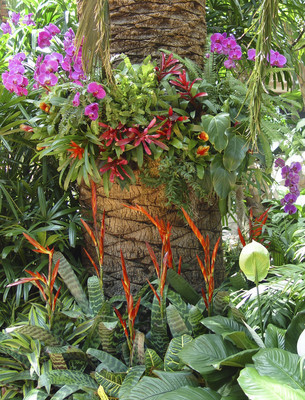Blooming bromeliads
It's hotly debated whether the fierce Carib Indians of the Island of Guadalupe were cannibals. So named "Canibales" by the Spanish to describe their ferocious defense against the invaders, it is more likely that this tribe was mislabeled. Yet reports of Columbus discovering the first pineapples beside a bubbling pot of human body parts in an abandoned Carib village persist to this day. So while the Carib's taste for human flesh is doubtful, we do know that the explorer returned to Europe with this succulent fruit.
While it was widely coveted, this crop of the tropical bromeliad plant could not be cultivated anywhere near a frost. It and the rest of the bromeliad family remained relatively obscure in horticulture until the invention of the heated greenhouse in the 19th century. Then interest in this exceptional clan of exotics from Central and South America exploded.
It's not the true pineapple that interests today's gardeners except for a small group of Floridians. It's the rest of the family that is pure tropicalia. These foliage plants are so unique in color, flower and character that they spawned an avid plant hunting trend that brought the full range of qualities into the breeder's hands. The round whorl of strap leaves is fabulously colored in many of the species and cultivars. But it's the flowers that make these beauties a stand out at the florist and indoor plant section of the garden center.
Oddly enough the bromeliad blooms but once in its life span, just like the agave or century plant. It is done much the same way, producing a bloom about three years after planting. In preparation to bloom, the plant shifts its energy from producing foliage to development of the bloom stalk. The bloom spikes are almost always neon bright and offer intense color relished by florists and interior designers. But it is the long lasting quality of the bloom, sometimes over two months, that makes them so popular. They are far more easy to manage than are the tropical helaconia.
The bromeliad crop is produced by growers who bring them to the retail market just as the bloom is reaching full size. With dozens of types commercially grown they can be selected purely for their flowers alone. But if you look at the foliage, which can be brightly colored, striped and spotted, you'll discover they are truly fabulous houseplants. However, they don't last forever.
Once the bloom fades it discolors and should be cut away at the base of the stalk. If you buy a vivid foliage type you still have a great looking plant that can live for up to two years, but it will not grow larger. In fact, it will gradually decline with time. But once flowering begins, the bromeliad is preparing to produce offsets or "pups" at the base of each plant. These little plantlets can grow as large as the parent with time. If they are gently severed after reaching a good size, you'll find that a new pup may grow in its place.
The newly severed pup may or may not have roots attached. Either way, plant it gently into a new pot with soil similar to that of the mother plant. Keep moist and give the pup the same lighting and it will mature into a new blooming plant that will flower identically to the parent in one to three years.
The rule of thumb is to grow hard-leaf bromeliads in bright filtered lights. Soft-leaf types will require more shade because they originate beneath a protective jungle canopy. If the leaves turn brown, give the plants less light and more moisture.
Bromeliads enjoy a humid climate, so strive to keep the soil evenly moist but well drained. They love bathrooms and shower stalls with natural lights or full spectrum lighting.
For more info on these wonderful plants, log on to the Bromeliad Society International at http://www.bsi.org
Maureen Gilmer is a horticulturist and host of "Weekend Gardening" on DIY Network. Contact her at her Web site www.moplants.com or visit www.diynetwork.com.





























